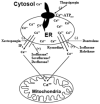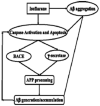Anesthesia, calcium homeostasis and Alzheimer's disease
- PMID: 19199872
- PMCID: PMC2735723
- DOI: 10.2174/156720509787313934
Anesthesia, calcium homeostasis and Alzheimer's disease
Abstract
While anesthetics are indispensable clinical tools generally safe and effective, in some situations there is grown concern about selective neurotoxicity of these agents; the clinical significance is unclear as of yet. The mechanisms for inhalational anesthetics mediated cell damage are still not clear, although a role for calcium dysregulation has been suggested. For example, the inhaled anesthetic isoflurane decreases endoplasmic reticulum (ER) calcium concentration and increases that in the cytosol and mitochondria. Inhibition of ER calcium release, via either IP(3) or ryanodine receptors, significantly inhibited isoflurane neurotoxicity. Neurons made vulnerable to calcium dysregulation by overexpression of mutated presenilin-1 (PS1) or huntingtin (Q-111) proteins showed enhanced apoptosis upon isoflurane exposure. Sevoflurane and desflurane were less potent than isoflurane in altering intracellular calcium, and produced less apoptosis. Short exposures to inhalational anesthetics may provide neuroprotection by preconditioning via a sublethal stress, while prolonged exposures to inhalational anesthetics may induce cell damage by apoptosis through direct cytotoxic effects.
Figures


Similar articles
-
Effect of inhalational anesthetics on cytotoxicity and intracellular calcium differently in rat pheochromocytoma cells (PC12).J Huazhong Univ Sci Technolog Med Sci. 2008 Feb;28(1):104-9. doi: 10.1007/s11596-008-0127-4. J Huazhong Univ Sci Technolog Med Sci. 2008. Retraction in: J Huazhong Univ Sci Technolog Med Sci. 2008 Jun;28(3):372. PMID: 18278471 Retracted.
-
Inhalational anesthetics induce cell damage by disruption of intracellular calcium homeostasis with different potencies.Anesthesiology. 2008 Aug;109(2):243-50. doi: 10.1097/ALN.0b013e31817f5c47. Anesthesiology. 2008. PMID: 18648233 Free PMC article.
-
The common inhaled anesthetic isoflurane increases aggregation of huntingtin and alters calcium homeostasis in a cell model of Huntington's disease.Toxicol Appl Pharmacol. 2011 Feb 1;250(3):291-8. doi: 10.1016/j.taap.2010.10.032. Epub 2010 Nov 6. Toxicol Appl Pharmacol. 2011. PMID: 21059370 Free PMC article.
-
Effect of the inhaled anesthetics isoflurane, sevoflurane and desflurane on the neuropathogenesis of Alzheimer's disease (review).Mol Med Rep. 2015 Jul;12(1):3-12. doi: 10.3892/mmr.2015.3424. Epub 2015 Mar 4. Mol Med Rep. 2015. PMID: 25738734 Free PMC article. Review.
-
Dual effects of neuroprotection and neurotoxicity by general anesthetics: role of intracellular calcium homeostasis.Prog Neuropsychopharmacol Biol Psychiatry. 2013 Dec 2;47:156-61. doi: 10.1016/j.pnpbp.2013.05.009. Epub 2013 May 28. Prog Neuropsychopharmacol Biol Psychiatry. 2013. PMID: 23721657 Free PMC article. Review.
Cited by
-
Azi-isoflurane, a Photolabel Analog of the Commonly Used Inhaled General Anesthetic Isoflurane.ACS Chem Neurosci. 2010 Feb 17;1(2):139-145. doi: 10.1021/cn900014m. Epub 2009 Oct 12. ACS Chem Neurosci. 2010. PMID: 20228895 Free PMC article.
-
General Anesthetic Use in Fragile X Spectrum Disorders.J Neurosurg Anesthesiol. 2019 Jul;31(3):285-290. doi: 10.1097/ANA.0000000000000508. J Neurosurg Anesthesiol. 2019. PMID: 29734272 Free PMC article. Review.
-
Resveratrol pretreatment attenuates the isoflurane-induced cognitive impairment through its anti-inflammation and -apoptosis actions in aged mice.J Mol Neurosci. 2014 Feb;52(2):286-93. doi: 10.1007/s12031-013-0141-2. Epub 2013 Oct 15. J Mol Neurosci. 2014. PMID: 24126892
-
Neurocognitive Adverse Effects of Anesthesia in Adults and Children: Gaps in Knowledge.Drug Saf. 2016 Jul;39(7):613-26. doi: 10.1007/s40264-016-0415-z. Drug Saf. 2016. PMID: 27098249 Review.
-
Sevoflurane induces endoplasmic reticulum stress mediated apoptosis in hippocampal neurons of aging rats.PLoS One. 2013;8(2):e57870. doi: 10.1371/journal.pone.0057870. Epub 2013 Feb 28. PLoS One. 2013. PMID: 23469093 Free PMC article.
References
-
- Xie Z, Tanzi RE. Alzheimer’s disease and post-operative cognitive dysfunction. Exp Gerontol. 2006;41:346–359. - PubMed
-
- Culley DJ, Xie Z, Crosby G. General anesthetic-induced neurotoxicity: an emerging problem for the young and old? Curr Opin Anaesthesiol. 2007;20:408–413. - PubMed
-
- Fodale V, Quattrone D, Trecroci C, Caminiti V, Santamaria LB. Alzheimer’s disease and anaesthesia: implications for the central cholinergic system. Br J Anaesth. 2006;97:445–452. - PubMed
-
- Wise-Faberowski L, Zhang H, Ing R, Pearlstein RD, Warner DS. Isoflurane-induced neuronal degeneration: an evaluation in organotypic hippocampal slice cultures. Anesth Analg. 2005;101:651–657. - PubMed
-
- Wei HF, Liang G, Yang H, Wang QJ, Hawkins B, Madesh M, et al. The common inhalational anesthetic isoflurane induces apoptosis via activation of inositol 1,4,5-trisphosphate receptors. Anesthesiology. 2008;108:251–260. - PubMed

